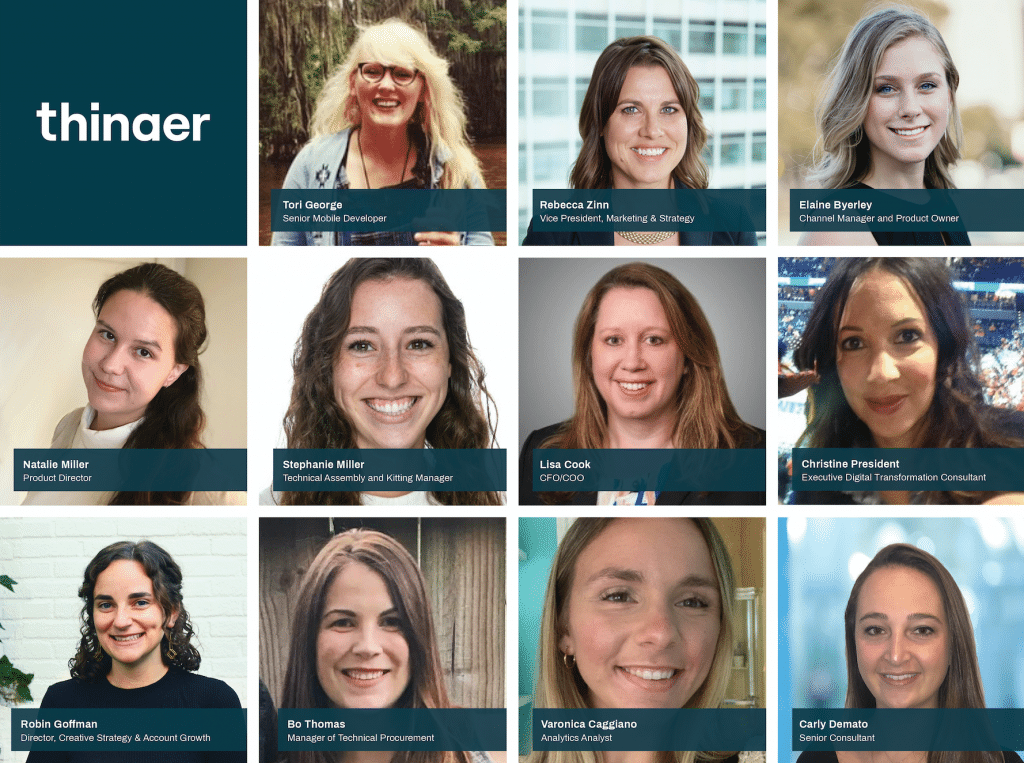Women comprise about half of the US workforce, but only 27-percent of workers in science, technology, engineering, and math (STEM) careers. Research cites a number of factors contributing to this. To start, young women often have fewer female role models in STEM. Additionally, some theories suggest that negative stereotypes dissuade women from pursuing STEM careers. Furthermore, once women start in technology careers, they leave at a higher rate. A study by Accenture and Girls Who Code found that women leave tech positions a 45% higher rate than men.
How can we change this dynamic and cultivate greater inclusion in the technology industry? In honor of Women’s Month, the women on Thinaer’s team came together to share their thoughts and ideas.
Introduce Girls to Technology at an Early Age
By fostering more interest and talent in girls at a young age, we can encourage more women in technology careers. “Early adoption can break down the subject intimidation barrier, which will hopefully build to knocking down the representation barrier,” says Bo Thomas, Manager of Technical Procurement. “Things like coding classes and clubs being implemented in elementary, middle, and high schools are so important.”
Programs for women of all ages, from elementary school through college, expose both interest and talent otherwise unknown. “In college, I interned at a technology company,” says Stephanie Miller, Technical Assembly and Kitting Manager. “It helped me see that this sector is interesting and relevant.”
“I think if people learned more about tech from an earlier age, they would find a lot of things that interest them, says Carly Demato, Senior Consultant. “In the past, young men were exposed to technology via video games earlier in life, and therefore pursued STEM careers. I do think is changing. More girls and young women participate in computer-related activities at an earlier age.”
Encourage Young Women to Find Role Models & Mentors
Mentors help girls and young women see others thriving in technology roles. As more women enter technology, girls will see it’s somewhere that they can succeed. “We know that people generally want to fit in, so showing young women that they can fit into the tech sector by showing more women in tech goes a long way,” says Natalie Miller.
“It is important for women in technology to find mentors,” says Lisa Cook, CFO/COO. “You can find mentors through networking groups, your job, your school– finding those people organically is so important. Have a talk with them, tell them how they can help you. Always ask how you can help them. Even if it’s someone you look up to, there are always things you can do to help them as well.”
Varonica Caggiano says, “I originally went to school for bio – switched to bioinformatics because I realized I liked coding from watching my dad do it for so many years. Now I am working as a data analyst/data visualization and working towards getting my masters in Data Science. I don’t know where I would be without programming/analyzing data, it’s a fun process – frustrating at times but I love it.”
Provide Women in Technology with the Resources Needed to Thrive
In addition, women launch only 25 percent of startups. There are opportunities to provide women founders with capital and other resources. “I also think that funding for women-led tech businesses needs to be particularly cultivated, because there’s a gender divide in men vs women when asking for money or help in general,” says Natalie Miller, Product Director. “We need to make up that divide by approaching women-led tech differently than what has been the status-quo so far.”
“There is a plethora of online communities that support the advancement of women in technology, and in the workplace overall. A few of these resources I find incredibly encouraging include: Ladies Get Paid, Women Who Code, Women Making Waves, and Girlboss. My latest podcast binge is “The Two Percent” hosted by Female Founders Fund, a fund investing in the exponential power of exceptional female talent. The more we can foster supportive communities to empathize with each other, share knowledge, and learn from each other, the more inspired we can all be to succeed,” says Robin Goffman, Director of Creative Strategy & Account Growth.
Cultivate An Inclusive Workplace
As noted above, women in technology leave the industry at a higher rate than men. Many times, they cite workplace culture among the reasons they leave. For instance, of women who work in predominantly male workplaces, only 48 percent of women indicate that they are treated fairly regarding recruitment and hiring. Furthermore, only 38 percent say that they are treated fairly regarding promotions.
This illustrates the importance of creating work cultures that enable all people to thrive. To close the gender gap, address unconscious bias, cultivate inclusion, and provide women with opportunities to grow. It starts by creating inclusive workplace policies and systems. “These statistics often translate to a workplace designed for men,” says Thomas. “We need more women in the room when policies are designed. We need more women in positions to make decisions, make change.”
“People want to bring their authentic selves to work,” says Rebecca Zinn, Vice President of Marketing & Strategy. “To retain women in technology roles, employers can examine the culture, communication styles, and perspectives that are valued, and those that are not. Is there inherent bias rooted in the cultural assumptions that the organization regards as desirable or valuable? If so, what can be done to change that, to make space for different approaches?”
A note for women who are interviewing:
For women interviewing for new roles, the Thinaer team recommends investigating the work culture, before accepting an offer. “I wish I knew when I was a younger employee that in an interview, you can interview the company on their culture and make sure diversity and women’s issues are something that is important to them,” says Tori George, Senior Mobile Developer. Cook adds, “talk to as many people as you can within a company as you interview. Try to talk to the women. Ask about opportunities for advancement, the culture of the company, and you’ll find out quickly if it’s somewhere you can succeed.”
Elaine Byerley, Channel Manager and Product Owner, offers advice to women. “With the technology sector being predominantly male, I would advise women to be confident in their abilities, share their ideas, and make their voice heard. It is common to feel overshadowed when you are the only female in the room, remember that your opinions and input is valuable and you are there for a reason. ”
Create Learning Opportunities for Women in Technology
Encourage girls and women to take risks and identify opportunities that will build new skills. “We don’t necessarily have the same self-confidence as men that we can take up certain roles,” says Cook. “Just having the confidence to do it, make mistakes, and take on those challenges is so important. I took a risk by accepting a leadership role in a sector I had no background in, and it ended up being such a fantastic experience– I learned so much that has helped further my career. There are so many opportunities out there if you just take them.”
There are many accessible ways for women to learn and expand their skills. “The outlets for women and other minority groups in technology are so vast,” says George. “The support of other women is incredible and something that helps me so much. The amount of free classes and workshops, especially, in the pandemic is such a great tool to use.”
“When I entered the technology sector, I was really drawn to the fact that you could learn and build on skills from scratch to then create a whole new business right from your living room,” says Natalie Miller. “The barrier to entry was relatively low when I learned to code, and it seemed a little bit like magic with every new skill you acquire.”
Educators and employers can encourage their teams to attend technology events. “When the pandemic ends… go to a hackathon or a startup weekend,” says Natalie Miller. “You don’t need to be an expert. You don’t need to be a coder. They’re a lot more fun than they initially seem, and if you happen to be naturally social, you’ll have a big leg up.”
Conclusion
Christine President, Executive Digital Transformation Consultant, offers a parting encouragement. “After moving from pharma to tech, I was exposed to thought provoking innovative approaches within all functions of the enterprise, ” she says. “It opened a whole new world for me. I was so inspired to be on the side of driving change and developing customer centric solutions. The possibilities are endless and I have been pushed beyond my comfort zone…..so exciting!”


